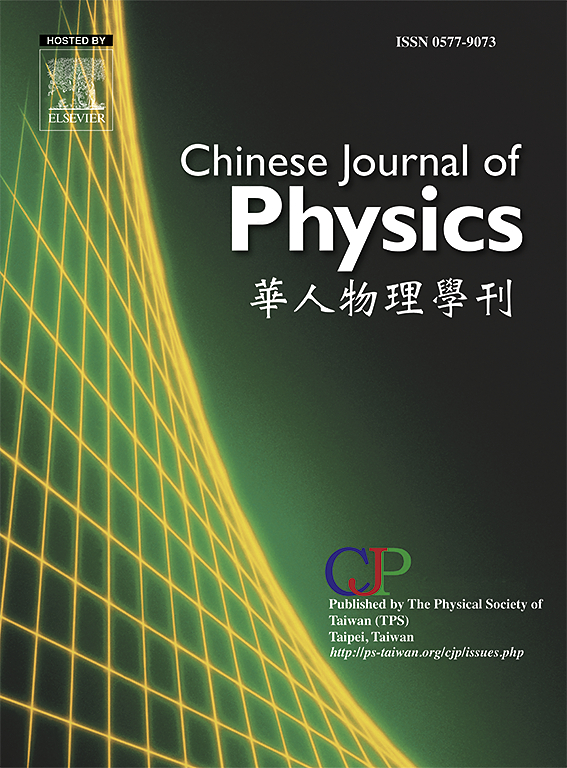Joule heating and viscous dissipation impact on MHD-hybrid nanofluid flow over non-isothermal stretching/shrinking surface: Dual solution and stability analysis
IF 4.6
2区 物理与天体物理
Q1 PHYSICS, MULTIDISCIPLINARY
引用次数: 0
Abstract
Recent scientific research has consistently demonstrated that hybrid nanofluids have superior thermophysical properties, promising heat transfer efficiency improvers in engineering applications. Thus, the aim of this study is to numerically examine the effects of the magnetohydrodynamic (MHD), suction, Joule heating and viscous dissipation parameter on the intricate flow and thermal transfer dynamics of a hybrid nanofluid streaming over a permeable non-isothermal surface with a further investigation into duality of solutions. Similarity transformation reduced the governing equations into ordinary differential equations (ODEs), which were resolved using the MATLAB bvp4c function. The concurrent effects of the governing parameters on the temperature and velocity profiles, local skin friction coefficient, and the local Nusselt number were examined by hybridizing magnetite (Fe3O4) and multi-walled carbon nanotubes (MWCNT) immersed in water. The most notable finding of this study reported a higher magnetic parameter and nanoparticle volume concentration increased the skin friction coefficient in the shrinking region. Remarkably, a higher Eckert number increased the thermal boundary layer and reduced the heat transfer rate. Stability analysis confirmed that the first solution was physically stable and reliable. These discoveries contribute valuable insights into optimizing heat transfer in advanced engineering systems where precise thermal control is critical and guidance for scholars in investigating the experimental or numerical dimensions of flow dynamic of hybrid nanofluid.

焦耳加热和粘性耗散对mhd -混合纳米流体在非等温拉伸/收缩表面上流动的影响:双溶液和稳定性分析
近年来的科学研究一致表明,混合纳米流体具有优越的热物理性质,有望在工程应用中提高传热效率。因此,本研究的目的是数值研究磁流体动力学(MHD)、吸力、焦耳加热和粘性耗散参数对混合纳米流体在可渗透非等温表面上的复杂流动和传热动力学的影响,并进一步研究溶液的对偶性。通过相似变换将控制方程简化为常微分方程,利用MATLAB bvp4c函数求解。通过将磁铁矿(Fe3O4)与多壁碳纳米管(MWCNT)混合浸入水中,研究了控制参数对温度和速度分布、局部表面摩擦系数和局部努塞尔数的影响。本研究最显著的发现是,较高的磁性参数和纳米颗粒体积浓度增加了收缩区域的皮肤摩擦系数。值得注意的是,较高的Eckert数增加了热边界层,降低了换热率。稳定性分析证实了第一种方案在物理上是稳定可靠的。这些发现为优化先进工程系统中的传热提供了有价值的见解,其中精确的热控制至关重要,并为研究混合纳米流体流动动力学的实验或数值维度的学者提供了指导。
本文章由计算机程序翻译,如有差异,请以英文原文为准。
求助全文
约1分钟内获得全文
求助全文
来源期刊

Chinese Journal of Physics
物理-物理:综合
CiteScore
8.50
自引率
10.00%
发文量
361
审稿时长
44 days
期刊介绍:
The Chinese Journal of Physics publishes important advances in various branches in physics, including statistical and biophysical physics, condensed matter physics, atomic/molecular physics, optics, particle physics and nuclear physics.
The editors welcome manuscripts on:
-General Physics: Statistical and Quantum Mechanics, etc.-
Gravitation and Astrophysics-
Elementary Particles and Fields-
Nuclear Physics-
Atomic, Molecular, and Optical Physics-
Quantum Information and Quantum Computation-
Fluid Dynamics, Nonlinear Dynamics, Chaos, and Complex Networks-
Plasma and Beam Physics-
Condensed Matter: Structure, etc.-
Condensed Matter: Electronic Properties, etc.-
Polymer, Soft Matter, Biological, and Interdisciplinary Physics.
CJP publishes regular research papers, feature articles and review papers.
 求助内容:
求助内容: 应助结果提醒方式:
应助结果提醒方式:


